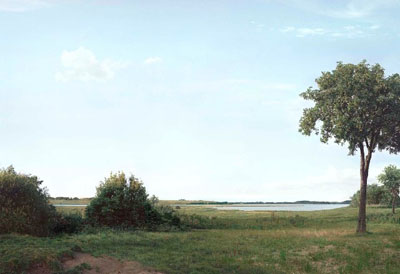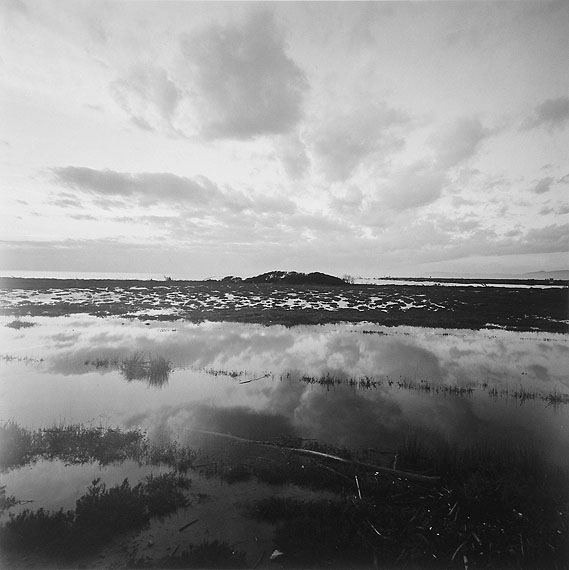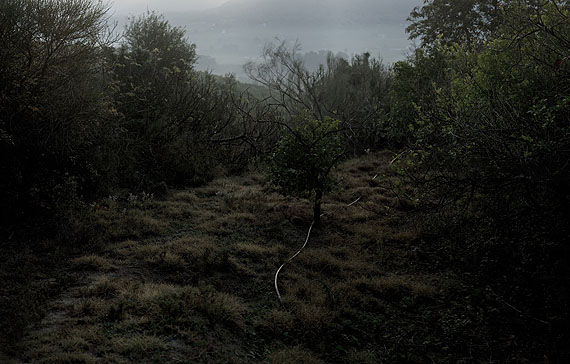
C-Print
116 x 169 cm
2001
Courtesy Louise and Eric Franck Collection, London, Beate Gütschow
© VG Bild-Kunst Bonn 2010
Double Fantasy
Beate Gütschow » Jan Jedlicka » Michal Seba »
Exhibition: 22 Apr – 4 Jul 2010
Galerie Rudolfinum
Alsovo nabrezi 12
110 00 Praha
+420 22-7059205
galerie@rudolfinum.org
www.galerierudolfinum.cz
Tue-Sun 10-18

Il Cerchio - The Circle
silverprints
26,5 x 26,6 cm
Maremma 2005–2009
The concept of the Double Fantasy exhibition is based on the vibrant relationship of the academic doctrine of European landscape productions of the 17th century closely tied to names such as Claude Lorraine or Nicolas Poussin, and its reuse in modern digital photography. The historicist academic landscape was always knowingly created outside of time and space - outside of reality, but also in the most real form possible. The precedent was not the reality of nature, but the reality of an academic doctrine, of a dream of a landscape as it should have been. It was the revitalization of a classical myth which was played out in the scene of a landscape as a representation of the ancient past. The art of Beate Gütschow comes the closest to this process. She approached the landscape from a conceptual position as if constructing a painting, through which she brought the theme, to a certain degree, not of a depiction of a specific place, which is essentially irrelevant, but mainly of the used method. She almost literally used the landscape academic doctrine as a model. Through the help of classic analogous photography she created a large cache of traditional painting motifs, but of course in current landscapes, which she then digitalized, and through the help of computer programs, she compiled them according to the mentioned academic principles into the form of current large-format ideal landscapes. For today’s photographers, the problem of the authenticity of nature rightfully comes to the forefront, as we are mainly surrounded by such nature in Europe – thus the problem of the history of human impact on the landscape. It is on this level that Jan Jedlička deals with the problem of the relationship of the ideal landscape with today’s landscape in front of the lens of a camera. He works with a landscape that at first shows characteristics of a nature essentially untouched by humans – flat, lowland spaces with minimal vegetation and in somewhat of a petrified state. In reality, this is a landscape which was fundamentally changed by humans: ancient swamps have been reclaimed and dewatered, and the land is partially cropped. The flat, empty space, with its minimal background which could anchor our look into the distance, induces a feeling of endlessness and the passing of time through the use of a wide-angle lens emphasizing the deepness of the expanse. Jan Jedlička captures individual shots according to a precisely-thought-out system and rigorously investigates every detail. He traces fixed points – the same square, thus non-dynamic static format with the horizon always dividing the image in half, leads us to a space free of people in a long line of dozens of snap shots. Jedlička does not create a framed (or separated from reality) image – he is not interested in an artificially-structured ideal landscape. His interest is focused on a landscape which is reduced to its very bottom – the selected essence of the formative and structural richness of simple products of nature. The use of classic black and white photographs (the absence of colour) also creates a technological return to the past, which underlines the movement toward the primary round, which existed perhaps even in prehistory. The maximum utilization of the new technology of digital photography for the benefit of emphasizing and deepening the reality of a landscape which it is capturing is the essence of the work of Michal Šeba. The composition of shots is similar to that of Jan Jedlička – often only a section of reality, not an inside-turning artificial structure which ends at the border of the frame. It is a distinctly real world. Yet with its lighting adjustments, it evokes an intensive feeling of magical situations awakening the imagination from the captured atmosphere. Despite the pronounced romanticizing haze, Šeba’s photographs are technologically closer to actual reality than any other method of depiction. Šeba’s technology of multiple utilization of the full capacity of the scanning chip enables the traditional fault, the loss of sharpness and drawing into depth as it happens with classic photography, to be removed. This means that his shots almost perfectly copy reality, which is of course in each moment and in each detail, without taking into consideration the distance from the place from which it is viewed, still fully drawn, fully sharp, and real. This is a problem that painting has been dealing with for hundreds of years. What is important for our theme is his thought-out work with the history of depicting through precise cuts and contrasting connections. In its final consequence, the art of all three artists asks a very urgent question of the origins of the archetype of generally-shared idea – the concept of the ideal landscape. The question asks if the idea arises from nature itself or from the immensely richly-structured concept of nature stored in and handed down by classic pictures in museums and galleries. And further, to what extent the academic landscape became the discovered image, and what part of it became the basis for artistic, intellectual and philosophical thinking subsequently forming the whole of culture. The second question is the level of our acculturation – the level of the influencing our perception and selecting the ideal configuration of a landscape through our upbringing and education arising from historical heritage in the simple perception of nature, but also mainly when affecting it, during its forming, and adaptation to our concepts. Another question is the relationship between the artistic interpretation of nature and the simple record of reality in view of form and its final result, thus what mental operations, associations, expectations and intellectual processes this simple record is able to evoke. The film at the end of the exhibition will try to answer these questions through the simple form of a four-hour, uninterrupted record of reality – a direct view into a selected segment of reality. The Double Fantasy exhibition is accompanied by a richly-illustrated catalogue with texts by the author and curator of the exhibition, Petr Nedoma. The catalogue also contains an extensive study by Marie Rakušanova, who deeply analyzes the indicated questions. The catalogue was published by the KANT publishing house in Prague.

The Hose
c-print, diasec
180 x 283 cm
2007